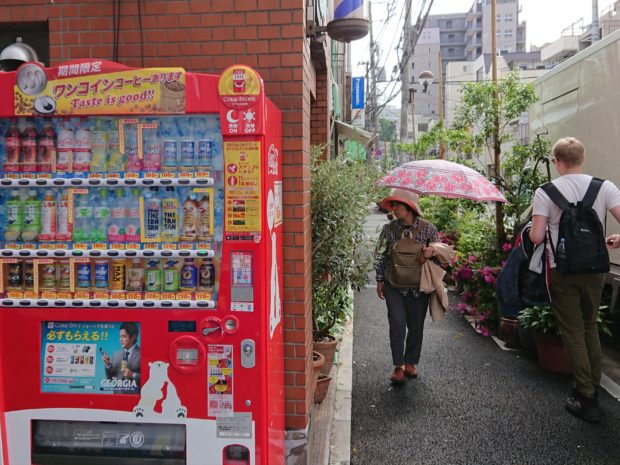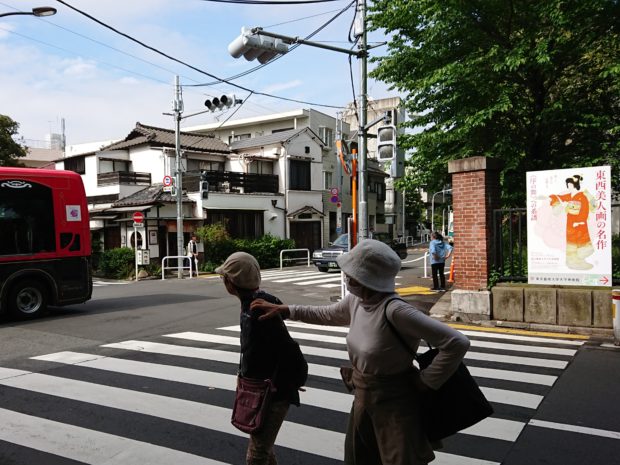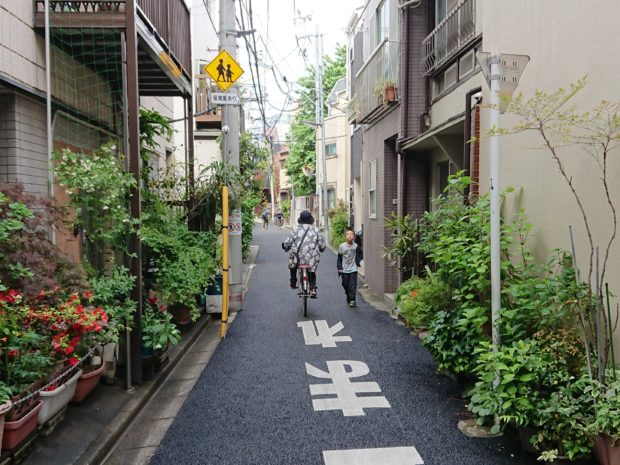You have no items in your cart. Want to get some nice things?
Go shopping
Read part one of this series here.
Due to the back-and-forth nature of our trip, we gave ourselves only two days in Tokyo before we were scheduled to leave it. We would be back three more times in the weeks to come, but we wanted a taste of the capital as soon as we could get it. All those images we’d been fed through film and TV: noisy night-time arcades; dress-up karaoke booths; clusters of skyscrapers; neon lights pinging off cabs and rivers. How do you begin to absorb a city of Tokyo’s scale in such a short amount of time?
We stood by a window inside Shibuya train station and watched the infamous scramble crossing. All at once, the lights turn green for pedestrians heading in every direction. The streams of bodies clash and mix and eventually dissipate, like the lines of the Union flag exploding. I could take this, no big deal. If there’s one thing I pride myself on, it’s my ability to adapt. The fact that I was dropping off and startling myself awake every twenty seconds was pure biology – jetlag is jetlag. But I’d just been given a paper crane by an elderly stranger and I was damned if I wouldn’t learn to fit in here. Thankfully, we didn’t have to face the crossing that day. That would come later. For now, our friends would take us for a simple stroll around a park of black pines and stone bridges over a lake. I watched a man feed a duck. It was all my brain could take. A little more taxing on the old grey cells was the pastry I ate, shaped like a fish but stuffed with red bean paste – umami more than sweet to my sugar-coated palette. That tends to be the case with desserts beyond the geography of my people, Greeks and Middle-Easterners for whom syrup is a beverage. Being a glutton, I use local sweets as a way of sampling the national psyche. There’d be more to ingest.
The next day, refreshed from sleep, the Spouse and I faced a challenge: we had to find our way through Shinjuku station, one of the largest and busiest in Tokyo, to collect our three-week rail passes from the travel office. We were on our own. Bodies poured into the concrete concourse from every angle, moving in all directions, an indoor version of the Shibuya scramble. In our concern not to be tourists holding everyone up (we’d been living in London for years, and were hardened against such types) we moved with gusto towards anything. Like sharks, we simply had to keep moving. My eyes darted around trying to catch the English words on signs above, on columns, underfoot, anywhere they might be, with my feet never stopping for a moment. Somehow, we made it to the right desk, and soon the rail passes were in our hands.
From which they must never leave.
“If you lose this,” the smiling lady at the travel desk informed us, “it can’t be replaced.”
We’d spent hundreds of pounds on these bits of laminated paper. For a brief visit to Tokyo or a couple of other cities, a rail pass is unnecessary. But we were going to be crossing three islands, covering over a dozen cities, and relying on the reach and speed of bullet trains (Shinkansen) multiple times over our four-week stay. Our losing a rail pass would’ve been like Tess Durbeyfield losing her horse. The moment I found out this was a precious talisman, I began a mental countdown of the number of days I was still responsible for it.

We travelled to Ueno, heading for the Tokyo National Museum. We stopped off at a café by the park, where I used totally incorrect Japanese and potentially devastating finger-pointing to order two lattes.
“Panda latte?” the woman behind the counter asked.
I said yes, hoping for the best. Soon, I was carrying a tray bearing two lattes with panda faces made of chocolate powder. My first successful transaction in Japan, done.
When I sat down, it dawned on me: weren’t pandas more of a Chinese motif? Had we already made a faux pas by stumbling into a Chinese café in Japan?
Having later discovered a panda-themed gift shop across from the café, we deduced that the theme had something to do with Ueno Zoo and its special inhabitant. A relief. I bought a clear plastic umbrella, both because it was extremely cheap and yet another slice of Japanese culture I was apparently all too eager to appropriate, and we headed for the museum. That’s where I beheld a sight I would declare the most ingenious of all concepts, and just another notch in the post that was Japanese logic applied to daily life: an umbrella locker system. You insert your clear plastic friend into one of the numbered holders in a rack, lock it, and take the key with you. There’s an admirable trait that seems to run through Japanese life: if something can be improved, do it. Only the night before, my fragile mind had been blown watching our friend make our beds. She’d threaded attachments on the duvet cover through loops attached to the duvet itself, thereby making sure it stayed in place and the duvet held its shape within the fabric. And here we Westerners were, squirming under lumpy duvets, ignorant of the order that was missing from our lives! So now I was offered a useful service to keep my umbrella safely out of the way while we browsed the museum. Of course, I had to be directed to this useful service by a polite security guard after attempting to walk in with my lightly drizzled new purchase, like the barbarian I was.
The museum itself was exactly what we sought; an introduction to the arts, crafts and clothing of Japan. We entered to find the set of Metropolis: a cavernous hall with an imposing marble staircase lit by dim warm lamps. We moved through rooms of black-lacquer boxes and writing sets, to ones of armour and swords, to a chamber whose function appeared to be solely for rest. Cushioned seating faced a window looking out onto a terrace, a lake and a perfect green garden. The only break in the calm was the portentous sight of a Bakelite telephone perched on a plinth, casting shadows against the textured wallpaper. Over the next couple of hours, we took in theatre masks and costumes; kimonos; ceramics; intricate painted sculptures of dragons; paper screens. Most breath-taking of all, however, were the unrolled scrolls of Buddhist texts, mostly extracts from the Lotus Sutra, which were kept under glass. Gold lettering on indigo paper, sprinkled with flecks that glinted as you moved along them. Despite being an atheist, I’m always moved by the care of craft and the beauty of devotion in items of religious or ritualistic importance.
Though filled with enough wonder to make your ancestors twitch, most museums in Japan are strangely lacking in guidance. You get almost no explanation of the items on display, or their place in a wider context – not even in Japanese, as far as we could tell. But one of the messages that rang clear through the Tokyo National Museum is that, for a long time, Japanese art struggled to be seen as relevant or worthy to the West. While our modern forebears made art to be hung on walls or placed on plinths for socio-political critique, the Japanese decorated fabrics, crockery, or the very walls themselves. Beauty for the mere sake of it. Their art was a part of life, ours was an entity apart from it. I’d never realised this until we beheld some Japanese paintings, on canvases in frames, like something we’d see at our own National Gallery. It irritated me that the snobbery of the West had been forceful enough to bend the East its way. Japan’s idealisation of Western – particularly American – culture would poke through our entire honeymoon. Like carp in a pond, it could be seen even when it wasn’t breaking the surface.
The next stop on our Tokyo dash only reinforced the point. Being vegetarian and therefore a nightmare to travel with, I’d downloaded the Happy Cow app so as to filter out anywhere that served vegetables served in meat juice with a prawn garnish. We headed from the museum towards a place that met my requirements. First we walked along the main road through Ueno Onshi Park. But as we travelled further west, we slipped through a portal to another Tokyo, one before World War II. Non-skyscraper homes sat squat and white on street corners. Bicycles turned around them, ferrying middle-aged men in shirtsleeves and elderly women in floral-print jackets. There were tiled roofs and round windows, shrubbery, pine trees shading wooden staircases. Vending machines carrying iced coffee or cigarettes lined up against red-brick walls. In these neighbourhoods, electricity runs above ground. You walk beneath a network of cables and wires, half-expecting a gangster’s moll to invite you to a casino. It’s so charming a sight that our English friend swore he would complain to the council if they carried out their promise of hiding the electrics underground.
Eventually, we reached Tofu Room Dy’s. It sits nestled in one of these streets, with a window to catch anyone’s eye. Not for Dy’s the plastic food “samples” you find in front of every Japanese restaurant (more on those later); instead, it’s a Peanuts tableau. Snoopy mugs and clocks on a shelf. Snoopy parachuting down towards a Snoopy portrait in a frame. Snoopy stuck with suckers on the pane, reminding onlookers to “KEEP SMILING”.
Inside, a waitress and a chef greeted us warmly. Though neither woman spoke much English, they did the unconscionably polite Japanese thing of making us feel terrible by apologising for not knowing our language. I insisted, in English, that it’s we who should have learned theirs. Already feeling doltish, I used my phrasebook to explain my fussy eating habits, but the women were on it. After a few minutes’ wait, the waitress brought out a plate of the most delicious non-meat foods I’d had in a long while. We would be OK, I thought again. I remembered the parable I learned from a storyteller friend, with its wise message: As you are is as you’ll find it. If I approached Japan with open arms, she would return the gesture. I’d just have to learn more Japanese for when we left the city the next day.
My husband and I admired our sweet, homely surroundings. We chuckled as we pointed out the soul and funk vinyl sleeves adorning the walls; Diana Ross, Kool and the Gang. All our lives we’d been told how conformist the Japanese are, but here were these two women in their kooky, characterful establishment. Then a darker thought entered my head, and it wouldn’t shift through the duration of our stay: this country was bombed by the Americans, not so long ago. How did they choose, how were they able, to return that violence with so much love? And why was I so bothered by it, when I’m normally so We Are the World myself? I like melting pots, scrambles.
We left the restaurant with thanks and courteous bowing (now that we’d picked it up), and headed for a textiles shop my husband had set his sights on. We passed a delivery van, parked outside a small apartment block. The driver loaded a bike with Amazon parcels, and adjusted his baseball cap. America, I thought. It really had won.
To be continued.


About Polis Loizou
Polis Loizou is a co-founder of The Off-Off-Off-Broadway Company, which primarily performs his plays, and has had a series of successes since their first hit at the Buxton Fringe in 2009. His short stories have been featured in The Stockholm Review of Literature and Liars’ League NYC, and he is a frequent contributor to Litro Magazine. Born and raised in Cyprus, Polis is currently based in Nottingham after 14 years in London. 'Disbanded Kingdom' is his first published novel. He is currently represented by Litro's bespoke literary agency, Litro Represents.
- Web |
- More Posts(25)




